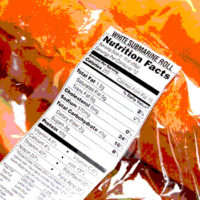Taking a Closer Look at Physical Contamination

Amateur golfers like myself cannot, in general, be relied upon to hit the ball straight and land it in the fairway. Believe it or not, this can cause problems for some food manufacturers. For example, wayward golf balls do land in fields where potatoes are being grown, causing them to become an unwanted addition to the harvest. During processing, standard X-ray technology commonly used in product inspection is unable to consistently discern between spherical golf balls and similarly shaped potatoes. Needless to say, food manufacturers need to ensure that there is no risk that any of these golf balls or for that matter any other foreign contaminant will make its way into the downstream production process and finally into the potato products which will be sold to the consumer.
This is just one illustration of the limitations of standard X-ray inspection technology for checking modern foodstuffs for contaminants. Consumers are seeking convenience from their food, to make it fit better with increasingly busy and mobile lifestyles. This means that consumption of goods such as prepacked fruit and salads and ready-made meals is rising, while snacking products such as packs of nuts and seeds, and breakfast cereals are also very popular. In food inspection terms, these products provide challenges, due to the complex, variable density of the foodstuffs and also sometimes the innovative packaging they come in. Stones in potatoes, salads, dry fruit and vegetables are common contaminants; rice products are commonly contaminated by stones and glass.
Conventional X-ray inspection technology is excellent at detecting certain types of contaminants in food products. Stainless steel, ferrous and non-ferrous metals, glass, calcified bone, mineral stone and high density plastics and rubber can all be identified in a food product and rejected accordingly. However, conventional X-ray technology has difficulties detecting inorganic contaminants, such as glass shards, low density plastics and rubber or stones and rocks, when present within a complex density product, that is, with high variations in density, such as a prepacked salad. Typically, the image produced by conventional X-ray technology in such products is crowded and indecipherable.
Clearly, this is a problem for food manufacturers, even more so in an age when consumers are increasingly conscious of food standards issues. Brand reputations are at stake, and no manufacturer wants to endure the embarrassment, not to mention the short- and long-term costs, of a product recall due to contamination of food by objects that should have been removed before reaching the supermarket shelves.
A Ground-Breaking Solution
.jpg) It is for this reason, that Eagle Product Inspection has harnessed its cutting-edge Material Discrimination X-ray technology, or MDX, for use by food manufacturers. MDX is an enhanced X-ray technology that can discriminate between high and low X-ray channels. When X-rays are directed onto a food product, a proportion of the X-ray energy is absorbed by the product, depending on the product’s composition, while the rest of the energy passes through to a detector (Figure 1).
It is for this reason, that Eagle Product Inspection has harnessed its cutting-edge Material Discrimination X-ray technology, or MDX, for use by food manufacturers. MDX is an enhanced X-ray technology that can discriminate between high and low X-ray channels. When X-rays are directed onto a food product, a proportion of the X-ray energy is absorbed by the product, depending on the product’s composition, while the rest of the energy passes through to a detector (Figure 1).
Each ingredient in a product has its own atomic number, and the higher the atomic number, the greater proportion of X-ray energy is absorbed. Carbon, with an atomic number of six, therefore absorbs much less X-ray energy than lead, which has an atomic number of 82. MDX has a detector array that gives values at two different energies and a relative ratio of energy absorbed can be calculated to determine a material’s composition. Foreign body detection therefore becomes based on chemical composition, that is, atomic number rather than just density variation or product thickness.
MDX can detect flat glass and stone in mixed nuts, for example, which conventional X-ray finds very challenging. It is not just the food within the packaging that can affect detection. Innovative packaging designs such as fold-out cardboard sandwich packaging and corrugated card encasements also provide challenges in foreign body detection for standard X-ray inspection technology—challenges that MDX is able to overcome.
The development of MDX for product inspection has followed the demands of food manufacturers that need a reliable solution to detect and remove contaminants irrelevant of product type or packaging format. In the case of MDX, this technology has also been used in the security industry for some years to help find contraband, weapons and stowaways in cargo containers.
Proof Is In the Product
Customers are already benefiting from MDX technology. Potatoes are big business in the Northwestern United States, producing more than one-half of the total U.S. potato acreage. One manufacturer in the region has been able to grow its business by using MDX to detect low-density rocks and golf balls during production, and thereby guarantee the quality of its potato products.
Meanwhile, in Poland, a cereal manufacturer has deployed eight Eagle X-ray inspection systems with MDX technology after receiving complaints about glass being found in its products. The complaints have ceased in the wake of MDX being introduced.
Looking to the Future
There are also potential future uses for MDX beyond that of the inspection of complex density food products. For instance, the technology might also be used to measure ingredients to simplify the classification of products for food labelling.
What is certain is that with modern lifestyles calling for ever greater convenience in food consumption (and indeed you might argue while golf courses are being situated close to potato fields), the issues of contamination and complexity in the food production chain are not going to go away. The consumer needs to feel confident that every effort is being made to ensure that only high quality produce makes it into the supermarket, and the damage to a brand through failing to meet these exacting standards is something that food manufacturers can ill afford. Ground-breaking X-ray technologies such as MDX can make that failure a thing of the past.
Kyle Thomas is strategic business unit manager at Eagle Product Inspection. For more information, visit www.eaglepi.com.
Looking for a reprint of this article?
From high-res PDFs to custom plaques, order your copy today!




